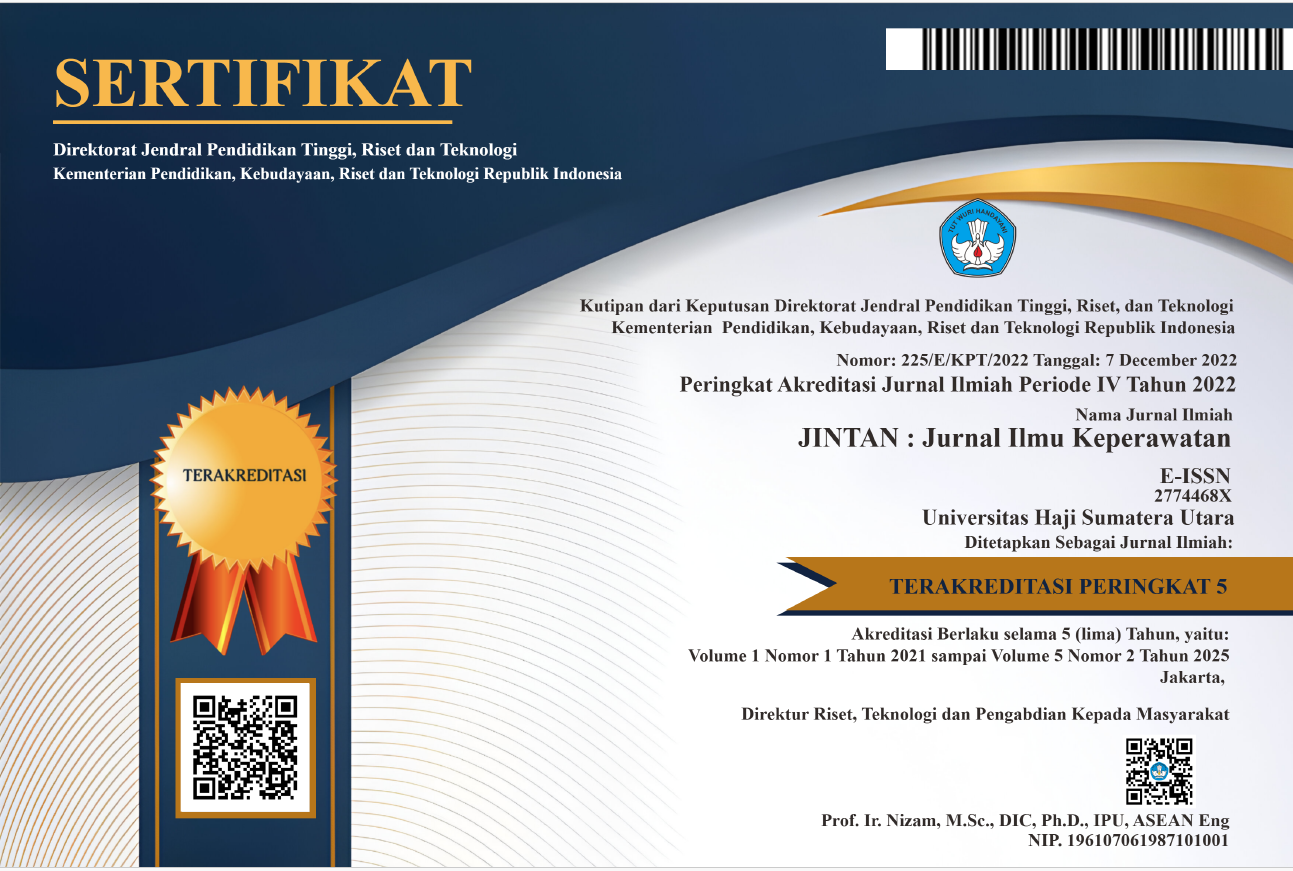Statistika Deskriptif
DOI:
https://doi.org/10.51771/jintan.v4i2.859Keywords:
statistika deskriptif, ukuran frekuensi, ukuran pemusatan, dispersiAbstract
Pemahaman tentang statistika diperlukan oleh perawat sebagai dasar untuk melakukan asuhan keperawatan berdasarkan praktik berbasis bukti dan untuk tujuan penelitian. Artikel ini bertujuan untuk membahas jenis-jenis statistika deskriptif. Statistika deskriptif terdiri dari tiga bagian utama: ukuran frekuensi, ukuran pemusatan, dan ukuran variasi atau dispersi. Statistika deskriptif adalah metode untuk meringkas data mentah menjadi data terorganisir dengan cara yang valid dan bermakna. Pada artikel ini, penjelasan masing-masing jenis statistika deskriptif disajikan secara ringkas diikuti dengan contoh nyata dari berbagai hasil penelitian sehingga lebih mudah dipahami. Artikel ini dapat digunakan sebagai dasar pemahaman statistika bagi perawat dan mahasiswa keperawatan.
References
Adamson, K. A., & Prion, S. (2013). Making Sense of Methods and Measurement: Measures of Variability. Clinical Simulation in Nursing, 9(11), e559–e560.
Dahlan, M. S. (2013). Teori Sederhana Prosedur Pemilihan Uji Hipotesis (3rd ed.). Jakarta: Salemba Medika.
Desu, B., Birrie, E., Tilahun, L., Zeleke, M., & Nebiyu, S. (2023). Acute Coronary Syndrome and Associated Factors among Patients Visiting Dessie Comprehensive Specialized Hospital Emergency Department, Dessie, Ethiopia, Cross-Sectional Study, 2020. International Journal of Africa Nursing Sciences, 19, 100583.
Dunn, D. S. (2001). Statistics and Data Analysis for the Behavioral Sciences. Boston: McGraw-Hill.
Franzese, M., & Iuliano, A. (2018). Descriptive Statistics. Encyclopedia of Bioinformatics and Computational Biology, 1–13.
Giuliano, K. K., & Polanowicz, M. (2008). Interpretation and Use of Statistics in Nursing Research. AACN Advanced Critical Care, 19(2), 211–222.
Heiman, G. W. (2011). Basic Statistics for the Behavioral Sciences (6th ed.). USA: Wadsworth, Cengage Learning.
Koivisto, J., Buure, T., Engblom, J., Rosqvist, K., & Haavisto, E. (2023). The Effectiveness of Simulation Game on Nursing Students’ Surgical Nursing Knowledge — A Quasi-Experimental Study. Teaching and Learning in Nursing, 00, 1–8.
Lee, J. (2020). Statistics, Descriptive. International Encyclopedia of Human Geography (Vol. 13). Elsevier.
Mishra, P., Pandey, C. M., Singh, U., Gupta, A., Sahu, C., & Keshri, A. (2019). Descriptive Statistics and Normality Tests for Statistical Data. Annals of Cardiac Anaesthesia, 22(1), 67–72.
Nishikimi, M., Numaguchi, A., Takahashi, K., Miyagawa, Y., Matsui, K., Higashi, M., … Matsuda, N. (2018). Effect of Administration of Ramelteon, a Melatonin Receptor Agonist, on the Duration of Stay in the ICU: A Single-Center Randomized Placebo-Controlled Trial. Critical Care Medicine, 46(7), 1099–1105.
Omotosho, T. O. A., Sey-Sawo, J., Omotosho, O. F., & Njie, Y. (2023). Knowledge and Attitudes of Nurses Towards Pain Management at Edward Francis Small Teaching Hospital, Banjul. International Journal of Africa Nursing Sciences, 18, 100534.
Plichta, S. B., & Garzon, L. S. (2009). Statistics for Nursing and Allied Health. Philadelphia: Wolters Kluwer Health | Lippincott Williams & Wilkins.
Prion, S., & Adamson, K. A. (2014). Making Sense of Methods and Measurement: Frequencies. Clinical Simulation in Nursing, 10(1), e53–e54.
Privitera, G. J. (2019). Essential Statistics for the Behavioral Sciences (2nd ed.). Los Angeles: SAGE Publications, Inc.
Unjai, S., Forster, E. M., Mitchell, A. E., & Creedy, D. K. (2023). Predictors of Compassion Satisfaction among Healthcare Professionals Working in Intensive Care Units: A Cross-Sectional Study. Intensive and Critical Care Nursing, 79(August), 103509.
Downloads
Published
Issue
Section
License
Copyright (c) 2024 Mula Tarigan, Dewi Frintiana Silaban

This work is licensed under a Creative Commons Attribution-ShareAlike 4.0 International License.








